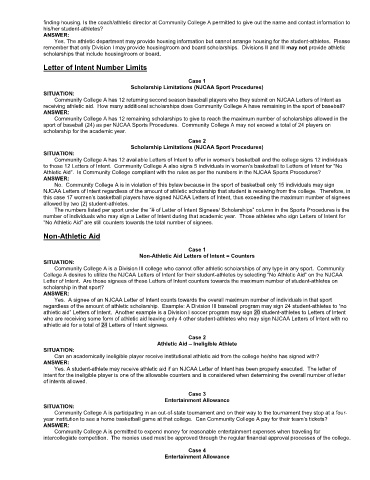Page 297 - 2019-20 NJCAA Handbook - May, 2020
P. 297
finding housing. Is the coach/athletic director at Community College A permitted to give out the name and contact information to
his/her student-athletes?
ANSWER:
Yes. The athletic department may provide housing information but cannot arrange housing for the student-athletes. Please
remember that only Division I may provide housing/room and board scholarships. Divisions II and III may not provide athletic
scholarships that include housing/room or board.
Letter of Intent Number Limits
Case 1
Scholarship Limitations (NJCAA Sport Procedures)
SITUATION:
Community College A has 12 returning second season baseball players who they submit on NJCAA Letters of Intent as
receiving athletic aid. How many additional scholarships does Community College A have remaining in the sport of baseball?
ANSWER:
Community College A has 12 remaining scholarships to give to reach the maximum number of scholarships allowed in the
sport of baseball (24) as per NJCAA Sports Procedures. Community College A may not exceed a total of 24 players on
scholarship for the academic year.
Case 2
Scholarship Limitations (NJCAA Sport Procedures)
SITUATION:
Community College A has 12 available Letters of Intent to offer in women’s basketball and the college signs 12 individuals
to those 12 Letters of Intent. Community College A also signs 5 individuals in women’s basketball to Letters of Intent for “No
Athletic Aid”. Is Community College compliant with the rules as per the numbers in the NJCAA Sports Procedures?
ANSWER:
No. Community College A is in violation of this bylaw because in the sport of basketball only 15 individuals may sign
NJCAA Letters of Intent regardless of the amount of athletic scholarship that student is receiving from the college. Therefore, in
this case 17 women’s basketball players have signed NJCAA Letters of Intent, thus exceeding the maximum number of signees
allowed by two (2) student-athletes.
The numbers listed per sport under the “# of Letter of Intent Signees/ Scholarships” column in the Sports Procedures is the
number of individuals who may sign a Letter of Intent during that academic year. Those athletes who sign Letters of Intent for
“No Athletic Aid” are still counters towards the total number of signees.
Non-Athletic Aid
Case 1
Non-Athletic Aid Letters of Intent = Counters
SITUATION:
Community College A is a Division III college who cannot offer athletic scholarships of any type in any sport. Community
College A desires to utilize the NJCAA Letters of Intent for their student-athletes by selecting “No Athletic Aid” on the NJCAA
Letter of Intent. Are those signees of these Letters of Intent counters towards the maximum number of student-athletes on
scholarship in that sport?
ANSWER:
Yes. A signee of an NJCAA Letter of Intent counts towards the overall maximum number of individuals in that sport
regardless of the amount of athletic scholarship. Example: A Division III baseball program may sign 24 student-athletes to “no
athletic aid” Letters of Intent. Another example is a Division I soccer program may sign 20 student-athletes to Letters of Intent
who are receiving some form of athletic aid leaving only 4 other student-athletes who may sign NJCAA Letters of Intent with no
athletic aid for a total of 24 Letters of Intent signees.
Case 2
Athletic Aid – Ineligible Athlete
SITUATION:
Can an academically ineligible player receive institutional athletic aid from the college he/she has signed with?
ANSWER:
Yes. A student-athlete may receive athletic aid if an NJCAA Letter of Intent has been properly executed. The letter of
intent for the ineligible player is one of the allowable counters and is considered when determining the overall number of letter
of intents allowed.
Case 3
Entertainment Allowance
SITUATION:
Community College A is participating in an out-of-state tournament and on their way to the tournament they stop at a four-
year institution to see a home basketball game at that college. Can Community College A pay for their team’s tickets?
ANSWER:
Community College A is permitted to expend money for reasonable entertainment expenses when traveling for
intercollegiate competition. The monies used must be approved through the regular financial approval processes of the college.
Case 4
Entertainment Allowance

